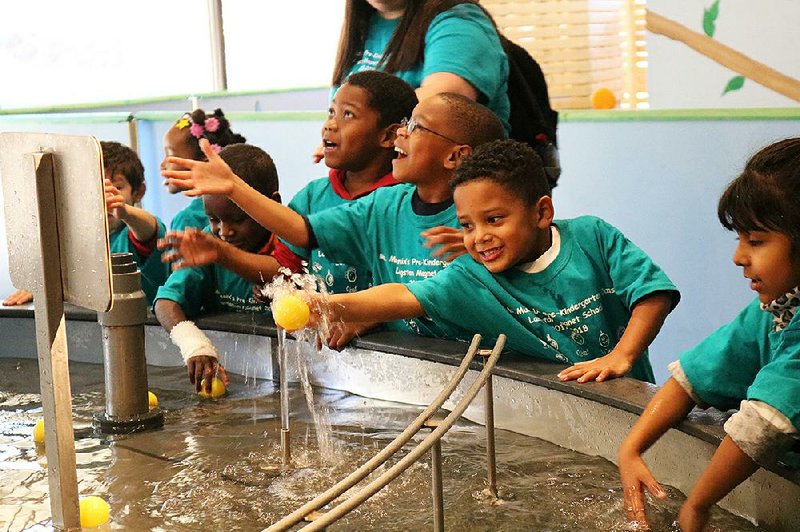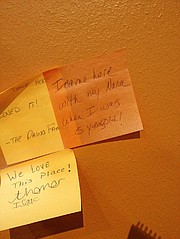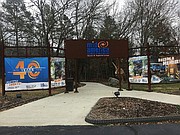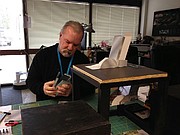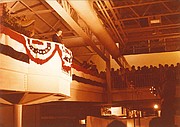The Mid-America Science Museum is a study in contrasts.
There it stands, surrounded by trees and a sense of peace and serenity. Yet, the inside is full of things that whirl and fly and flip. There are things to stack and things to climb. Even a person walking a trail through the woods might stop and say, "Wait. Is that a dinosaur?"
It's an unlikely place for a sophisticated science museum, in a community of only about 36,000 people.
Jim Miller, director of marketing, says, "A lot of people find it unorthodox that we're out here less than a mile from Hot Springs National Park. We have a state-of-the-art science museum. Not every major city has one of those."
Yet Hot Springs has had one for 40 years, and over the decades since it first opened, the museum has become one of the resort town's key tourist attractions along with downtown, Oaklawn and Magic Springs. It has also become a popular destination for school field trips and has racked up generations of students who are now bringing their own children, part of a continuing legacy of science-related play.
"If you're not one with the community, you just won't make it," says Niles Ellis, the museum's director of design.
And there have been times when people wondered if it would. It all began as a project for the Smithsonian Institution, which started talks in the 1960s, exploring possibilities for putting a science museum in Hot Springs. Things didn't get off to the best start. The Smithsonian plan fell through and, not long after the museum opened in 1979, the state legislative council cut the funding. The Arkansas Department of Parks and Tourism stepped in to take over, followed by the Hot Springs Advertising and Promotion Division. In the 1990s, it became an independent 501(c)(3) nonprofit.
"There aren't many nonprofits this old that haven't had struggles," Miller says.
In an effort to limit some future struggles, it is hoping to create an endowment to help handle the day-to-day operations. As it is, it depends on donations and admission fees to keep things going.
Considering the ups and downs, achieving the 40th anniversary mark is a big milestone and the museum's staff plans to celebrate all year long.
Later this month, the museum will have a 1979-theme float in the World's Shortest St. Patrick's Day Parade in downtown Hot Springs. There will be a pop-up historical photo exhibit downtown in June. It has also started the 1979 Club, where anyone who donates $1,979 or more gets special access and benefits. Taste of the Holidays, the annual fundraiser in November, will be the biggest yet, boasting a 1979 theme.
There will be more, Miller promises, but dates haven't been set yet.
"We have lots of fun, exciting things going on," says Chief Development Officer Harmony Hurst Morrissey. "It's a good time to be part of the museum."
Operations inside the museum are continuing normally but visitors will notice a few nods to the past.
Some of the exhibits have been around since the beginning, such as the whimsical sculptures by Rowland Emett and the ice cone. And visitors can easily pick those out now thanks to new signs distinguishing those museum veterans. There are also black-and-white photos from the museum's early days for then-and-now comparison.
Another visible nod to history is the big memory wall. The museum provides post-it pads and pens so visitors can write their notes and memories like "I came here with my Nana when I was 5 years old!"
But as a science museum, things are always moving forward, not just looking back.
Just look at the Oaklawn Foundation Tesla Dome Theater, added in 2015. Actually, many visitors look right past it. It blends in so seamlessly with the rest of the gallery, Miller says, it's "a hidden gem. Many people don't notice it."
But inside, it's a state-of-the-art theater that offers special shows on global sound scapes and the night sky. The latter show is a real-time simulation of the stars on that specific day, so it's always changing.
It is working on expanding the dome programming, thanks in part to membership in the NASA Museum Alliance.
"Hot Springs is an outdoor town," Miller says. And the museum takes advantage of its setting with nature-based programs. In recent years, it has expanded those outdoor offerings from simple walking trails to more hands-on features and programs. For instance, there's the Bob Wheeler Science Skywalk, which combines views of the property with interactive exhibits and a firefly-inspired structure.
Another outdoor feature is the new DinoTrek, which is spread out over the museum's 21 acres.
"Some people see the Tyrannosaurus rex and the triceratops in front and the pteranodon in the lobby and think that's the DinoTrek," Miller says. "There's a lot of walking trails behind the museum where guests can actually hike among the dinosaurs."
But most of the action is still inside, where visitors can explore an old cave and come face-to-face with a mastodon skeleton in the Arkansas Underfoot Gallery. Children can take part in special crafts and projects in the Tinkering Studio. Tiny little ones can play in the Kye-Yac Clubhouse, especially for babies and toddlers, while older kids climb on an indoor jungle gym or toss colorful balls into a unique water fountain.
No one knows all these exhibits, new and old, like Niles Ellis, the designer. He has been there since the museum's first year, or, as he says, "Since rocks were just dirt."
He started as a technician but worked his way up to being a designer, getting special training on how to create and maintain the various exhibits and shows that have come through over the years.
"I spend a lot of time out on the floor working on the exhibits," he says, which helps him understand how they work and how they need to be constructed for maximum durability. "You would just not imagine the kind of wear and interaction the exhibits get."
A self-described "inquisitive kind of guy" who loves to know how things work, he has had the opportunity to work with lasers, electricity, magnets, lighting, plumbing, carpentry, even scenery and set design when the big dinosaur exhibits come through.
Forty years is a long time for a science museum and one of the reasons it has lasted so long is its ability and willingness to change and adapt.
Ellis says, "You can't keep the museum the same way all the time. People, thank goodness, do come back and see us. After a few times, they're very familiar with what we have. It does us well to change it."
Miller agrees: "As a science museum, we always have to stay on the cutting edge. We always have to stay contemporary. We always have to stay out in front."
And it has adapted.
In the early 2010s, Miller says, "It was starting to feel its age and there was a push to move it downtown."
It was unable to come up with a feasible plan for a move so, in 2015 with a grant from the Donald W. Reynolds Foundation, the museum was expanded and renovated where it stood, refreshing exhibits and gallery spaces, improving outdoor spaces, and adding areas such as the dome theater.
Ellis says, "When I first came here, the museum was new. When we had the big rebuild, it was like Genesis. The museum had its own rebirth."
Miller adds, "Now it's more popular than ever."
There's talk of even more expansion, too, as it prepares to add about 5,000 square feet of space to the Arkansas Gallery. That should help with its plans to bring in bigger exhibits.
But one of its biggest goals it to build, design and distribute its own exhibits, a goal Miller says is shared among most science museums.
Speaking of sharing, it collaborates with the other big science museums in the state, the Museum of Discovery in Little Rock and the Amazeum in Bentonville, when it comes to promotion and membership. It's all in the name of science.
The museum has always been about science education but lately there's been even more of a focus.
A recent addition is the Science After School program for area children in kindergarten through eighth grade, 3:30-6 p.m. weekdays. There, children participate in age-appropriate science experiments and games.
According to Miller, the program began when the Garland County Boys & Girls Club closed, leaving a gap in after-school programs for children.
Ellis says, "We're not always held back by the rules of formal education. We can have a lot of fun with it. .... They didn't have that stuff years ago. When your child can go to an institution and can be taught things about rocketry, things about magnetry, things about electricity. ... We're breeding a whole new generation of scientists here."
Mid-America Science Museum
500 Mid-America Blvd., Hot Springs
Hours: 9 a.m.-5 p.m. Tuesday-Saturday, 1-5 p.m. Sunday Labor Day to Memorial Day; 9 a.m.-5 p.m. Monday-Wednesday and Saturday, 9 a.m.-7 p.m. Thursday, 1-5 p.m. Sunday Memorial Day to Labor Day
Admission: $10; children 3-12, senior citizens 65 and older, teachers, active and retired military $8
Tesla and Dome theater shows: $3
(501) 767-3461
It's a prime location for school field trips but some schools are too far away or too financially strapped to take the children there.
For those districts, Miller says, "We can take the science to the schools. We do large-format science shows that get the kids excited about science."
It also has a volunteer program specifically for teenagers, Team Tesla, that helps out with summer day camps and Girls in STEM, a series of workshops to encourage girls' interest in science.
Education starts even at the youngest ages.
"We get 1-year-old babies in here and their eyes light up," Miller says. "When you expose a child to science, they're stimulated."
The museum depends on community support to keep going and that community, they say, has always come through.
According to Ellis, "I think the greatest thing right now probably is it's embedded itself into the community. So many people have visited over the past that the name, Mid-America, has become synonymous with the museum."
And it supports the community in turn.
Ellis says, "We want to go out of our way to make them feel at home, to enjoy what we have here for them. I think every employee here enjoys what they're doing and we enjoy sharing it with everyone who comes to visit us."
Style on 03/05/2019
